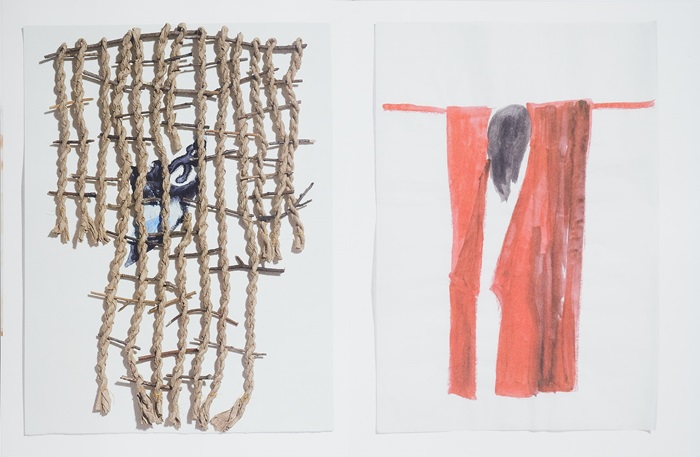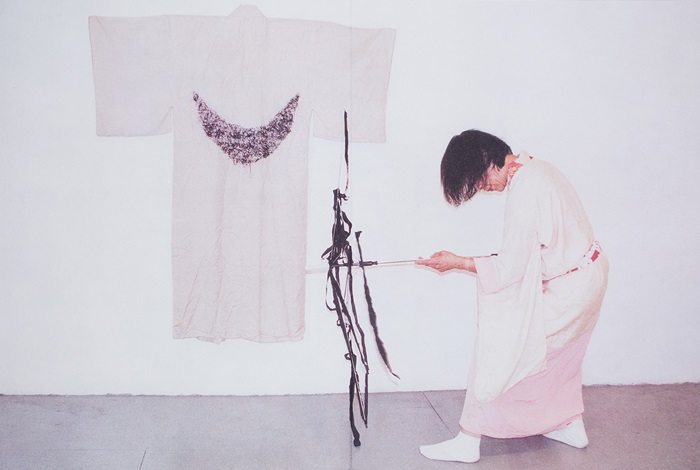The 12 April 2024 marked the public opening of the refurbishment of Tradu/izioni d’Eurasia, the exhibition organised by MAO for the 700th anniversary of Marco Polo’s death. The most significant changes include numerous important loans from the Uffizi, the Biblioteca Laurenziana, Florence, the Musei Civici, Bologna and the Museo della Ceramica Duca di Martina, Naples and site specific works by the French-Moroccan artist Yto Barrada. The exhibition is accompanied by a rich programme of talks, concerts, screenings and performances, offering visitors opportunities for reflection and new readings of the complex, fascinating story that has unfolded along the Silk Road across the centuries.
Image above: Kazuko Miyamoto, Artist book 2016, Published by Matador / La Fabrica, Madrid, Spagna with the support of SAAB Courtesy of the artist and EXILE gallery
On 12 April, MAO is unveiling the refurbishment of Tradu/izioni d’Eurasia, an exhibition that tells the fascinating story of the journey of art, culture, traditions and language from East Asia to the Mediterranean basin (and back) through a new, well-chosen selection of pottery, textiles, metalwork and manuscripts. Like Marco Polo, people travelled along the caravan routes that connected Asia and Europe across thousands of years. Travelling alongside with them were ideas, motifs and knowledge, an entire migrating heritage – material and immaterial – that put down roots everywhere it arrived through a steadfast process of adaptation. Tradu/izioni d’Eurasia tells this story, a tale made up of connections, influences and betrayals: it is our story, a narrative that unites far-flung corners of the Eurasian continent more than we are inclined to believe and shows that the concept of “border” has always been illusory and arbitrary. The story unfolds in thematic sections alternating with forays into the contemporary world and united by a new version of Chiara Lee and freddie Murphy’s site-specific sound installation Distilled, which has been developed and added to beyond its October 2023 iteration.
The new display opens with an installation by the Berlin studio Zeitguised and explodes with the theme of blue, often paired with contrasting white: precious vases, plates and bowls of disparate provenance (from China to Delft, passing through Iran), on loan from the Museo delle Civiltà, Rome, the Museo Internazionale delle Ceramiche, Faenza and the Museo Nazionale della Ceramica Duca di Martina, Naples, and two masterpieces by Giovanna Garzoni, from the Gallerie degli Uffizi, Florence.
The paintings, both of which are vibrant still lifes, feature a Chinese vase and cup decorated with typical white and blue motifs, attesting to the fluidity with which objects and iconographic themes have always circulated across Eurasian, whether brought as gifts or sold along the trade routes. Through painting, Garzoni depicted the ties between Asia and Europe and the powerful fascination with the exotic that began bewitching the European courts, especially that of the Medici in Florence, in the fifteenth century. Art talking about art, in a play of references and decorative motifs that echo – familiar, yet different – at distant latitudes and in remote periods.
The next section is devoted to the theme of grapes and, by extension, wine. Central to Sogdian culture, wine was used not only for libations and during Zoroastrian rituals but also trade. In the exhibition, the decorative motif of the bunch of grapes is represented by pottery from China, Turkey and Iran – attesting to its wide circulation – and an extraordinary Japanese obi by the master artisan Yamaguchi Genbei: a five-metre length of fabric decorated with the well-wishing grape motif.
The heart of the reload is a series of site-specific works by the French-Moroccan artist Yto Barrada, the exhibition’s guest of honour. Drawing inspiration from Color Problems: A Practical Manual for the Lay Student of Color by Emily Noyes Vanderpoel (1842–1939), for Tradu/izioni d’Eurasia Reloaded Barrada made a series of eight medium-sized canvases that take an at once both archival and poetic approach to exploring the subject of colour and its meanings in works in the MAO collection. The series is of course an homage to Noyes Vanderpoel, a scholar, activist, artist and patron of the arts who was based in New York in the early twentieth century, but it is especially a narration of subterranean and subordinate stories linked to the theme of diaspora and cultural influence. A story that dispenses with words in favour of the silken materiality of velvet. Yto Barrada’s project was realised in collaboration with the Fondazione Merz, where the artist will hold a solo exhibition in the autumn of 2024. She is the winner of the fourth Mario Merz Prize, a biennial award instituted in 2013 with the aim of identifying and supporting individuals in the fields of international contemporary art and music.

Yto Barrada’s works have been placed in dialogue with textiles and pottery on loan from the Fondazione Bruschettini per l’Arte Islamica e Asiatica. The new selection of works includes refined exemplars of Ottoman art decorated with the cintamani motif, an ancient religious symbol of Buddhist origin that was reformulated and reinterpreted as a symbol of sovereignty, power and well-wishes in Iran and Turkey and, more generally, the Islamic world. These artefacts are paired with a precious sixteenth- century illuminated manuscript of The Shahnameh or Book of Kings, by the Persian poet Ferdowsi, on loan from the Biblioteca Medicea Laurenziana, Florence. In some of the volume’s numerous and extremely fine illuminations, the Persian hero Rustam is wearing a mantle embellished with the cintamani motif.
Thanks to support from MAO and the Istituto per l’Oriente Nallino, Rome, The Book of Kings has been restored and digitalised: it was a complex, difficult project, but indispensable for being able to display the volume in the museum and for future use by the scholarly community. The manuscript will also be the subject of a public study day planned for June.
The next section explores at the scale motif, with metal and ceramic tableware from India, Turkey, Iran, China and Italy on loan from the Musei Civici, Bologna and a few important private collections. The scale pattern, symbolising good health and riches, was the result of multiple cultural and artistic encounters and can be considered an emblem of the “entangled worlds” at the heart of the exhibition. It returned, translated and readapted, in the symbol of the dragon and in that of the carp, just as the pilgrim’s flask type re emerged, represented in the exhibition by a splendid majolica exemplar from fifteenth-century Pesaro.
Next to the room of metalwork from the Aron Collection there is a new selection of seventh- and eighth-century samite, silk textiles used in the past for vestments and sumptuous clothing and embellished with animal motifs (lions and bulls in niches and birds in beaded circles). These textiles are echoed in a seventeenth-century Japanese painting of a Buddhist monk wearing a kesa (the traditional Buddhist mantle) that is as richly decorated as the fabric that covers his chair.
Die Ausstellung endet mit einer poetischen, immersiven Installation, Shimmering Mirage (Black), 2018, von Anila Quayyum Agha, die den Besucher in ein imaginäres Jenseits versetzt, und einem Leseraum des gleichnamigen Mailänder Verlags Reading Room (spezialisiert auf unabhängige Publikationen und Künstlerbücher), in dem auch eine Videoarbeit des libanesischen Künstlers Ali Cherri, The Watchman (2023), zu sehen ist. Das Video folgt Sergeant Bulut (eine postmoderne Version von Leutnant Drogo in Die Wüste der Tartaren), der in einem Wachturm an der südlichen Grenze zwischen der selbsternannten Türkischen Republik Nordzypern und der Republik Zypern stationiert ist. Dort, in einer Welt zwischen Realität und Fantasie, verbringt der Soldat endlose Tage und ebenso endlose Nächte in Erwartung eines Feindes, der nie kommt, bis am Horizont vage Lichter auftauchen, die dem Film eine gespenstische Schlusswendung geben. Der Film ist eine kraftvolle und notwendige Reflexion über die Konzepte von Grenze und Tod, die inhärente Gewalt der Grenze und die Absurdität der Kriegsrhetorik.

The final component of the exhibition is the light installation MOSADEGH (2023) by the Iranian artist Shadi Harouni, which invites reflection on themes like democracy and hope through the poetic and fierce account of the complex history of modern Iran, in dialogue with one of the 100 fragments of the copy of a Caucasian carpet made for the Pergamon Museum, Berlin as part of “CULTURALXCOLLABS – WEAVING THE FUTURE”, a participatory art project that goes beyond museum walls to engage with the community and create a dialogue between past, present and future, in an exchange between culture, museum and individuals with different stories and sensibilities. The project begins with the extraordinary story of a seventeenth-century Caucasian carpet decorated with a dragon motif. It entered the collection of the Berlin museums in 1881, but it was partially destroyed by a fire bomb during World War II, which spared only a few fragments. Using these fragments, a complex restoration project was launched in 2004 that gave the carpet the look of an almost graphic puzzle. In 2022, a copy of the carpet was made by hand in India for CulturalxCollabs – Weaving the Future and cut into 100 equal fragments, which began to circulate around the world, creating a tangible link between the museum, which is currently closed for renovations, and people, with the aim of generating a collective, shared narrative at the end of the project, planned for 2027.
The fragment-copy is displayed with two precious Caucasian carpets from the seventeenth
century: a large carpet with a floral pattern and two fragments of a carpet with a dragon motif, both from the Bruschettini Collection. These motifs, tied to traditional Chinese and Persian symbolism, evoke cosmological myths about the opposition of light and darkness, fertility and the origin of life, and symbolise power and spirituality.
In keeping with all of MAO’s exhibition projects, this refurbishment is also accompanied by a rich public program of musical events and performances, once again by Chiara Lee and freddie Murphy, and a series of talks and meetings that offer the public new opportunities for reflection on complex themes intimately tied to current issues.
The reload of the exhibition is accompanied by the rehang of the Islamic Asian Countries gallery, including the display of an extraordinary group of Kerman carpets, a particular type of rug from the Safavid period (1501–1722) called “vase carpets”: twelve precious fragments from the collection of the Fondazione Bruschettini per l’Arte Islamica e Asiatica and a rare large exemplar from MITA, the Museo Internazionale del Tappeto Antico, Brescia. The display of these carpets is a new instalment of the project “Flowers in Wool“, which began in Genoa in 2022 with the exhibition “I magnifici tappeti Sanguszko“, and the next instalment of which is an upcoming major exhibition of Kerman carpets from Italian collections.
Thanks to a partnership with the Istituto dei Sordi, Turin, the exhibition content will be available in LIS Lingua dei Segni italiana (Italian Sign Language) and in an audio version.
WHEN?
Exhibition dates: Friday, 12 April to Sunday, 1st September 2024
Opening hours: Tue-Sun, 10 am-6 pm
WHERE?
MAO Museo d’Arte Orientale
Via San Domenico 11
IT-10122 Turin
COSTS?
Ticket: 11 Euro
Reduced ticket: 8 Euro






